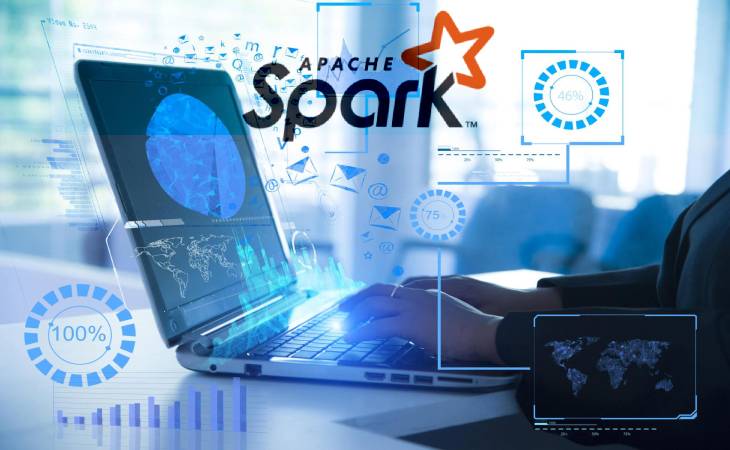Table of Contents
Introduction
Apache Spark, the future of big data platforms, is an integrated multi-language engine processing big data workloads across various domains. Furthermore, it is a prevalent choice for modern data pipelines as it delivers powerful features for executing batch processing, real-time streaming, data engineering, and machine learning.
Additionally, Spark supports code reuse across multiple workloads and provides development APIs in Java, Scala, Python, and R.
How Does Apache Spark Work?
Spark was developed to address the curbs of MapReduce by performing processing in memory, reducing job steps, and reusing data across parallel operations. With Spark, data is read into memory, computations occur, and results are written back in a single step – greatly accelerating execution.
Moreover, Spark leverages cached in-memory data to substantially speed up machine learning algorithms that repeatedly invoke functions on the same dataset. Data reuse is enabled through DataFrames, an abstraction over Resilient Distributed Datasets (RDDs), which are collections of objects cached in memory and reused across Spark operations.
Such significantly lowers latency, making Spark multiple times faster than MapReduce for tasks like machine learning and interactive analytics.
History of Apache Spark:
In 2009, at UC Berkley’s AMPLab, Spark began as a research project with a collaboration involving students, researchers, and faculty focused on data-intensive application domains. However, the goal was to create a framework optimized for fast iterative processing like machine learning and interactive data analysis while retaining the scalability and fault tolerance of Hadoop MapReduce.
“Cluster Computing with Working Sets,” the first paper entitled and published in June 2010 with Spark announced as open-source under a BSD license. In June 2013, the big data platform entered development status at the Apache Software Foundation and subsequently established itself as an Apache Top-Level Project in February 2014.
Features of Apache Spark:
Spark, an open-source big data platform, offers vital features: Simple, Fast, Scalable, and Unified.
- Batch and streaming data: By employing preferred languages like Python, SQL, Scala, Java, or R, Spark processes data in batches and real-time streaming.
- SQL Analytics: Regarding performance, the platform utilizes in-memory processing to run programs faster, making it well-suited for iterative algorithms and interactive data analysis.
- Scalability: Since fault-tolerant, it scales efficiently across clusters of machines to handle ever-growing data volumes.
- Machine Learning: Spark provides the MLlib library containing the implementations for various machine learning algorithms. Therefore, it allows smooth integration with popular frameworks such as TensorFlow and PyTorch.
- Open-Source & Community-Driven: As an open-source platform, it is freely available. In addition, it has a large community that actively contributes to its development to allow rapid innovation and expansion.
Use Cases of Apache Spark:
Some common use cases and applications valuing Apache Spark:
- Log analysis: To identify developments, troubleshoot issues, and enhance system performance, the unified engine analyzes large volumes of log data.
- Fraud detection: Through real-time streaming and machine learning models, Spark detects fraudulent activities promptly.
- Recommendation systems: On the conditions of the user’s past behavior and preferences, it enables personalized recommendations.
- Sensor data analysis: To monitor systems, optimize performance, and gain insights, Spark analyzes sensor data in real-time.
- Social media analytics: It analyzes data in social media to familiarize user behavior, track trends, and measure marketing campaigns.
- Data science analysis: Data scientists often use Spark in Jupyter notebooks or workbooks for faster iteration and analysis during feature engineering, model building, and algorithm development.
Pros of Apache Spark:
Speed: Regarding large-scale data processing, Spark is 100x faster than Hadoop.
Ease of Use: It offers easy-to-use APIs for operating on large datasets.
Advanced Analytics: Besides MapReduce, Spark similarly supports machine learning, graph algorithms, streaming data, SQL queries, etc.
Dynamic in Nature: The platform offers over 80 high-level operators, and users can easily develop parallel applications.
Multilingual: It supports several languages for coding, like Python, Scala, Java, etc.
Apache Spark is powerful: The big data platform can handle many analytical challenges due to its low-latency in-memory data processing capability.
Demand for Spark Developers: Spark not only benefits organizations but also individual users too.
Conclusion:
In conclusion, Apache Spark is fast, easy to use, general purpose, portable, scalable, and open source. These capabilities make it popular for big data processing and machine learning applications. Spark helps to ease the perplexing and computationally rigorous task of processing high volumes of real-time or stored structured and unstructured data.
In light of the good, the bad, and the ugly, the big data platform is a conquering tool when we view it from the outside. There have been astonishing changes in the performance and diminution in the failures across various Spark projects.
However, several applications are being moved to Spark for the efficiency it offers to developers. Using the big data platform boosts any business and helps foster its growth. With its power, flexibility, and vibrant community, Apache Spark empowers its users to tackle big data challenges effectively and unlock valuable insights from your data.

